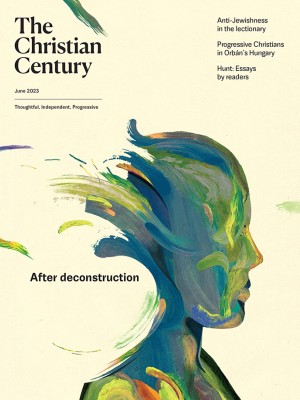Deconstructed, reimagined faith
Five ways I see a new generation reorienting its Christianity

(Illustration by Dadu Shin)
We are at a moment of cultural and spiritual deconstruction. That word is often associated with evangelicalism, as exvangelicals move away from conservative religious positions and begin to take apart and reimagine that inherited faith.
But I see evidence that deconstruction is more broadly representative of our moment. John, an Episcopal priest, finds himself embroiled in a heated controversy at his church after talking about the long imperial history of the Church of England in a recent sermon. Jennifer grew up in a suburban Presbyterian church that has always affirmed her call to ministry, but all her close mentors are men encouraging her to go into academia. Josh is a talented worship leader whose fusion of Polynesian and hip-hop influences has elicited strong pushback from the lead pastor of his church. Each of them is in a moment of deconstruction, coming from diverse cultural positions and for different reasons.
Read our latest issue or browse back issues.
In a time of far-reaching cultural upheaval, many spiritual deconstructionists find themselves ecclesially homeless, outside of churches that once nurtured their faith and identity. The way forward can appear daunting and bewildering.
But as I’ve studied the paths of deconstructionists, I’ve begun to see patterns in what often looks and feels like chaos. The following five shifts describe some of the ways people are reorienting faith after disorientation. This is not quite a road map, but each shift signals an important step in reimagining faith—via deconstruction—for another generation.
1. From triumphalism to lament. Deconstructionists often come to their moment of crisis because they are weary of the triumphant celebrations of their religious pasts. They’re skeptical of overvaluing the contributions of a sectarian church to a pluralistic present. Western Christianity, in various forms, has often been obsessed with what theologian Shoki Coe has called a “cathedral mentality.” That is, Western Christians often believe they must build permanent structures—physical and otherwise—that display and preserve their tradition’s greatness. As a result, faith systems witnessing a disproportionately high rate of deconstruction appear to foster an urgency about drinking deep from a narrowly circumscribed canon (e.g., scrupulously reading the prayers of Thomas Cranmer, the treatises of Jonathan Edwards, the apologetics of C. S. Lewis, or the writings of some other hero of the past). The goal is almost always, by doing so, to ascend the heights again.
Who doesn’t love a good mountaintop experience, especially when it means communing with spiritual giants? But many deconstructionists are learning that valleys and plains are also part of the spiritual journey. Or, to play on Isaiah 40, there is a time for soaring on wings like eagles and a time for running without growing weary and walking without losing heart.
For me, the triumphalist dynamic became most visible in my study of early evangelicalism and George Whitefield, the celebrity preacher known as the “Grand Itinerant.” When people heard that I was working on the later years of Whitefield’s life, not knowing I was attempting to place him in his imperial context, they would offer comments like, “Oh, that God would raise up more Whitefields in our day!” and “They sure don’t make ’em like they used to!” When I moved to San Francisco to work for an organization named after missiologist Lesslie Newbigin (which had an early flagship program called the William Wilberforce Fellowship), I saw how triumphalism rooted in hero worship could impact the life of organizations, often in surprisingly deleterious ways.
A cathedral mentality has shielded many Christians from the necessity of lament. As we come to understand more deeply the histories of empire, race, and slavery, turning away from triumphalism and toward lament feels like an appropriate spiritual response. Honest historical reckoning becomes part and parcel of a faithful spiritual life in the present. It’s a road that has led many deconstructionists from triumphalism to confusion, sorrow, and lament.
2. From morality to dignity. Many deconstructionists come from churches that have drawn a moral line between themselves and the rest of society. And they’ve come to experience deep weariness with the hypocrisy that has resulted, especially in the public performance of religion. As Cole Arthur Riley writes, “injustice has survived by cowering behind the guises of morality and ethics.” Deconstructionists have watched this dynamic with alarm as it plays out in the public square. They know well the dangers of theological convictions driving a political agenda while insisting one group knows better than another group what is best for all. In contrast, Arthur Riley argues, “true justice . . . is much more interested in protecting and affirming dignity with tangible actions.”
This does not mean that morality has no role to play in reimagining faith. Deeply moral questions fuel much of the spiritual discontent that leads to deconstruction. Passionate concern for the wrongs of misogyny, patriarchy, racism, and homophobia animate deconstructionist advocacy. But there is a shift in emphasis that begins to happen. Rather than moralizing, reconstructing faith leaders begin by affirming the dignity of every human being—and emphasizing the primacy of loving ourselves and each other in our moral complexity.
Teaching morality is easy; turn to just about any heroic story of scripture and even a novice preacher can find the plot of a sermon by exhorting, “Be like so-and-so.” Loving complicated people in the face of irresolvable ethical conflict is much harder. This doesn’t mean that vexing questions of biblical interpretation over contested moral issues are unimportant; it’s just that people are hurting and dying, and there are many more pressing matters of neighborly love vying for our attention on any given day. The shift from morality to dignity means remembering that when Jesus faced a choice between rule following and affirming a person’s dignity, it was never a hard choice.
3. From certainty to mystery. Disorientation comes when moments of absolute certainty give way to disappointment, when things don’t turn out as we hoped. For deconstructionists, it’s often the realization that biblical faith and interpretation are not so clear-cut, especially on any number of present-day social issues. Words mean multiple things, interpretations diverge, and mystery prevails. Just as American Christians once killed each other over racial slavery, often insisting they had the Bible on their side, scriptural arguments have the potential to spill over into violence today. Certitude is not faith, many are realizing, and the dogmatic imposition of a debatable interpretation is not love.
The danger is that many deconstructionists might simply embrace new certainties, rather than allow mystery and humility to prevail. We see this kind of certainty versus certainty everywhere in our society, but the way of faith leads us into deeper mystery. Faith remains, and confidence too, but there is a different hierarchy of belief, and mystery has a high place. After a long period of running for his life, the prophet Elijah appears vindicated on Mt. Carmel. He experiences a moment of empirical certainty: God had just answered his prayer by fire, after all, over and against all those people who had gotten it wrong. The story in 1 Kings 18 paints a scene of Elijah standing tall before all of Israel and slaying every false prophet of Baal and Asherah.
Before we know it, however, Elijah is on the run again—and close readers see that he retreats from the certainty of Mt. Carmel to the mystery of Mt. Horeb. After a ministry of power, coercion, and violence on Mt. Carmel, Elijah enters into quiet, rest, and a cloud of mystery and intimacy with God on Mt. Horeb. The second mountain deconstructs the first mountain as God appears to Elijah not in the wind, earthquake, or fire but in a still, small voice.
It may seem trivial, but for Elijah, after deconstruction comes delegation. God tells him to leave Mt. Horeb and go anoint others to lead. In other words, despite his loud protestations to the contrary, Elijah is not “the only one left,” and the time has come to make way for others to do the work he thought only he could do.
4. From superiority to mutuality. It should be clear by now that deconstructionists have grown skeptical of any claims to spiritual superiority. They understand how tempting it is for those who believe they have grasped universal truth to feel entitled to teach everyone else. Many were model Sunday school students who became exemplary teachers and preachers, rising pastoral stars, and influential denominational leaders. But when they questioned the wisdom of their community’s sense of religious superiority, deconstruction was not far behind.
Just as there are valid scholarly disputes around the cultural imperialism of missionary enterprises, some Christians are asking if they can hold on to their faith without feeling the need to make everyone else believe as they do. They can’t help wrestling with these questions, because they have seen the dangers of theological hubris, which is sometimes perilously indistinguishable from theological supremacy and its close kin White supremacy.
The whole situation brings to mind the folly of young Moses, schooled in the ways of Egypt, who went around “helping” those he saw in need because he felt he had an obligation to “save” them (the Hebrew verb attributed to Moses in Exodus 2:19 is yasa, which means “to save”). Moses in Exodus 2 is a veritable action hero, saving Hebrew men and Midianite women, putting ruffians in their place at a high cost to himself. By Exodus 3, it may be easy to miss that 40 years have passed, and we encounter a different Moses, older and less cocksure, more bent over, who says no to God five times. Moses has the audacity to beat around the burning bush!
The critical lesson might be easy to miss: Moses’ leadership shifts from superiority to mutuality. (To be clear, this does not make him immune to leadership blunders, as anyone who reads the rest of the story will see.) Young Moses, who had grown up in Egypt, could not imagine a world where he did not exercise his gifts to enact the justice he felt sure the world needed. Forty years later, slow of speech and with far more questions than answers, he finally musters the strength to return to Egypt only when God promises to send someone to walk alongside him. It turns out Moses, who once had the solutions to all the problems he saw in the world, needs his brother. (It will take longer, but in time he will also come to see how much he needs his sister.)
Moses’ frantic “saving” activity gives way to God’s deep relational activity: God “heard,” “remembered,” “saw,” and “knew” the suffering of the Israelites (Exod. 2:24–25). The last one especially, God knew (yada in Exod. 2:25), represents a sharp contrast to Moses who rescued (yasa in Exod. 2:19). For many deconstructionists, turning away from the lonely and harmful worldview of superiority (the way of yasa) is opening new pathways to the joy of mutuality (the way of yada).
5. From rhetoric to embodiment. It can be hard to keep up in the fraught, ever-evolving landscape of political and rhetorical correctness. Catchphrases and dog whistles abound, and many feel it’s easier to keep silent than to risk offending.
But the path of deconstruction does not allow its followers to be silent. Often people who come to deconstruction do so because they have seen people they love wounded by structures of power and religious certainty that can only be called abusive. They care above all about righting wrongs and repairing what unjust people and systems have broken. They want actions more than words, not exalted sermons but sacrificial service.
Once again, historical memory enables bold sobriety for the work of deconstruction. The much-celebrated civil rights movement of the 1950s and ’60s gave way to the less celebrated but no less important critical race theory in the ’70s because too many had conflated lofty rhetoric with actual change. Early scholars of CRT pointed out that Brown v. Board of Education did not end segregation in America, just as the Civil Rights Act and the Voting Rights Act did not stamp out racism. Instead of mighty waters of justice, they had witnessed some bursts and mostly trickles. Because of their disappointment, they expressed doubt about the achievements of the previous decades. They dared to assert that racism may be an enduring, perhaps permanent, feature of American civil society. In other words, soaring rhetoric did little to effect change on the ground, as the mountaintop gave way to valleys and plains.
In CRT’s pessimism, we might hear echoes of the hopelessness of Psalm 88, the one lament psalm to conclude without an expression of assurance or hope. Sometimes life—and scripture—must strain to make room for inexpressible sadness by turning away from easy answers, trusting that the last word today doesn’t have to be the final word for all time.
Deconstructionists are thus skeptical of aspirational language that enables privileged leaders to preserve the status quo. They want to see fundamental change, even if the costs are high, the loss of revenue streams inevitable, and the way forward unclear. They desire the quiet, rare embodiment of values: change on the ground.
In keeping with the spirit of deconstruction, it may be helpful to point out that these shifts do not represent the only way of virtue or progress. They do, however, appear to reflect the way of Jesus, who lived and wept in a world of sorrows, affirmed the dignity of every person he encountered, recognized the mystery of God and the world, and sought out relationships of mutuality. And all of this he did—despite being in very nature God—by embodying human flesh.
There’s no denying the work of deconstruction presents many pitfalls. I hope this survey has shown it’s also a profoundly hopeful, life-giving activity—precisely because of its very downward movement and its willingness to sit in the rubble and sift through the debris. Out of the chaos of deconstruction, there are signs of a faith renewed, stronger for having plumbed the depths. After halting steps in the dark, which many have experienced as refuge and rest, new pathways appear to be emerging. It turns out that dissatisfaction with inherited Christianity doesn’t always lead to a diminishment of faith.






